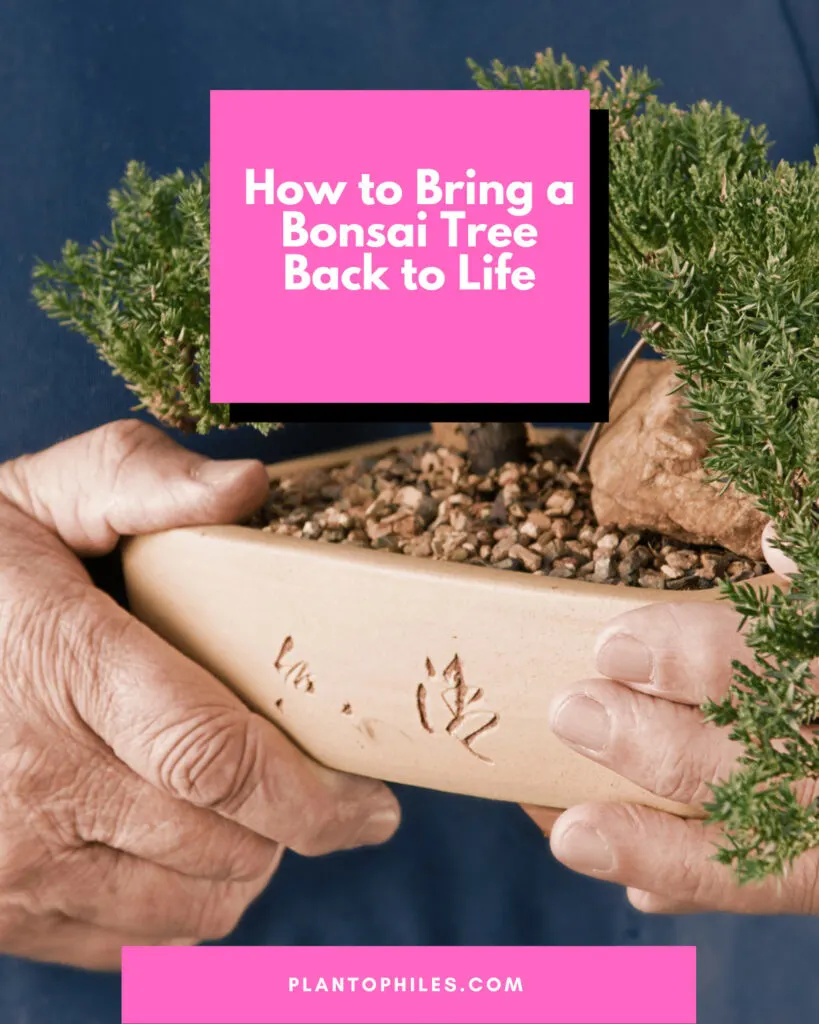Growing a Bonsai tree is truly an art form. From picking the parent tree to rooting, cutting, and shaping the new tree, it’s a one-of-a-kind experience.
But, Bonsai trees aren’t exactly known for being the easiest plants to grow and care for.
It can quickly die if the tree lacks enough light, even for a short period, or goes too long without water.
Read on to find out how to revive and bring back Bonsai trees from the brink of death.
Table of Contents
How to Bring a Bonsai Tree Back to Life?
Prune the branches and roots, repot the bonsai, water it, and relocate the tree to revive a dying Bonsai tree.

Necessary Steps to Bring a Bonsai Tree Back to Life
Step 1 – Pruning
The first step to bringing a Bonsai tree back to life is pruning away the dead and severely damaged areas.
Starting with the branches that are completely dried out, pluck off yellow and brown growth and then prune away all of the dead parts of the tree. This will encourage the tree to start new growth.
After removing the damaged areas, lift the tree from its container, rinse the roots off, and cut away any yellow or brown roots.
Now your tree’s energy will be directed towards establishing new growth and reviving itself rather than hopelessly attempting to save its dead or dying roots and branches.
Step 2 – Soak
The second step is simple: rinse off the roots and submerge the root ball in a container full of water. For many Bonsai trees, a drinking glass or mason jar is large enough to hold all of the roots.
If the tree is extremely dried out, you may also apply a fine mist of water to its top while its soaking.
Step 3 – Repot
Poor soil content is one of the main culprits that cause near-death situations with Bonsai trees. Bonsai trees require extremely quick-draining soil with a rocky bottom. Regular potting mix will almost certainly cause root rot or over-watering issues.
If the soil stays moist for days or even hours, it needs to be changed and is most likely why your tree almost died.
Line the bottom of the container with gravel with a thin layer of sand on top of it. Remove your tree from its leisurely soak and replant it with a well-draining soil mix on the sand and gravel.
Step 4 – Relocate
Another prime suspect cause of dead or dying Bonsai trees is their physical location. Bonsai trees, if handled with care, are extreme survivors. Some of these little guys live for hundreds of years.
If your tree is positioned in a poor location, it will almost certainly slowly die unless you move it to a better spot.
A huge mistake that many would-be Bonsai cultivators make in attempting to revive their Bonsai tree is putting it right back in the same position before they pruned, soaked, and repotted it.
Bonsai trees need exposure to as much sunlight as possible. That is why south-facing windows are an ideal location. If you don’t have enough natural light in your home, consider adding a plant light in your Bonsai space.
For Bonsai owners who keep their tree outside, ensure it doesn’t receive too much shade.
Step 5 – Water
Only once you’ve pruned off the damaged and dying parts of the tree, soaked it for a couple of hours, repotted it, and relocated it (if necessary), should you reinitiate a rigorous watering schedule.
Bonsai trees need watering religiously. Most of them require water at least once a day.
Depending on the size of the container it grows in, which determines the size of the roots, some Bonsais need as much as three or four waterings per day.
At any rate, each Bonsai tree is different and needs specific care. If you have more than one Bonsai tree, don’t treat them all with the same amount of water.
Bonsai trees are a bit more complicated than other house plants. You must learn the amount of water each tree requires and cater to their needs.
Step 6 – Rest
Once you take all of the above steps to bring your tree back to life, it’s time to let it rest. Further, it’s time for you to rest as well!
Caring for Bonsai trees is as simplistic as it is complex. They are unique house plants and should be treated carefully and carefully.
If you’ve grown your Bonsai tree from a cutting, you also have a special bond with it and want to see it live as long as possible.
Once you’ve made your best attempts at reviving your tree, continue watering it as normal and treating it as if nothing had ever been wrong.
If the tree survives the ordeal, signs of a full recovery will begin to pop up over the next few days or weeks.
Frequently Asked Questions
Why is my Bonsai tree dying?
Several factors may cause a Bonsai to begin dying. The most significant reasons are underwatering, overwatering, poor soil conditions (using the wrong soil mixture), and lack of proper lighting. All of which are reasonably simple to remedy.
How do I know if my Bonsai tree has root rot?
Root rot is a specific condition that almost all plants are at risk of developing at some time during their lifespan, Bonsai trees. To identify root rot on your Bonsai tree, look for blackish-colored areas on the trunk or branches. These areas will be directly below wilting and discolored leaves and branches drying out.

Daniel has been a plant enthusiast for over 20 years. He owns hundreds of houseplants and prepares for the chili growing seasons yearly with great anticipation. His favorite plants are plant species in the Araceae family, such as Monstera, Philodendron, and Anthurium. He also loves gardening and is growing hot peppers, tomatoes, and many more vegetables.


